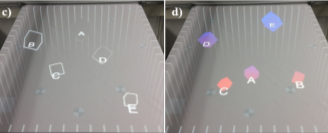Depth Perception in Projective Augmented Reality: An Evaluation of Advanced Visualization Techniques
PubDate: November 2019
Teams: Otto-von-Guericke-University,University of Koblenz,University of Magdeburg
Writers: Florian Heinrich, Kai Bornemann, Kai Lawonn, Christian Hansen
PDF: Depth Perception in Projective Augmented Reality: An Evaluation of Advanced Visualization Techniques

Abstract
Augmented reality (AR) is a promising tool to convey useful information at the place where it is needed. However, perceptual issues with augmented reality visualizations affect the estimation of distances and depth and thus can lead to critically wrong assumptions. These issues have been successfully investigated for video see-through modalities. Moreover, advanced visualization methods encoding depth information by displaying additional depth cues were developed. In this work, state-of-the-art visualization concepts were adopted for a projective AR setup. We conducted a user study to assess the concepts’ suitability to convey depth information. Participants were asked to sort virtual cubes by using the provided depth cues. The investigated visualization concepts consisted of conventional Phong shading, a virtual mirror, depth-encoding silhouettes, pseudo-chromadepth rendering and an illustrative visualization using supporting line depth cues. Besides different concepts, we altered between a monoscopic and a stereoscopic display mode to examine the effects of stereopsis. Consistent results across variables show a clear ranking of examined concepts. The supporting lines approach and the pseudo-chromadepth rendering performed best. Stereopsis was shown to provide significant advantages for depth perception, while the current visualization technique had only little effect on investigated measures in this condition. However, similar results were achieved using the supporting lines and the pseudo-chromadepth concepts in a monoscopic setup. Our study showed the suitability of advanced visualization concepts for the rendering of virtual content in projective AR. Specific depth estimation results contribute to the future design and development of applications for these systems.
